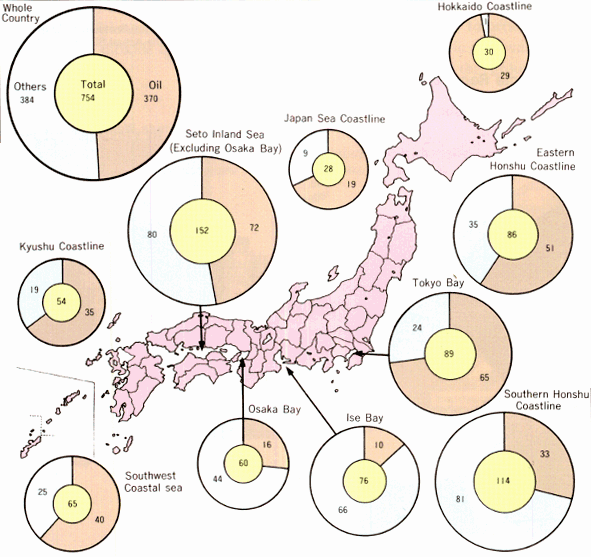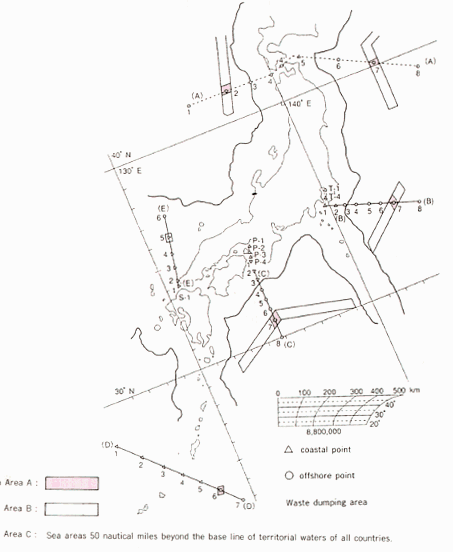Global Environment
Conservation of Marine Environment
Status
The annual number of reported marine pollution incidents in the coastal areas of Japan has remained at approximately 700 to 900 in recent years; half are oil-related incidents.
In 1996, marine pollution caused by oil spill totaled 370 cases, including 299 cases of oil spill from vessels. Among these, 86 cases were committed intentionally and 91 were the result of careless handling. Incidents caused by land-based sources numbered 179 and most of them were committed intentionally.
Countermeasures
Measures to prevent marine pollution can only be effective if all nations join forces to address the issue. The International Maritime Organization (IMO) plays a central role in promoting such international cooperation.
(1) Prevention of Marine Pollution from Ships
The Protocol of 1978 relating to the International Convention for the Prevention of Pollution from Ships, 1973 (MARPOL 73/78 Convention) was adopted in 1978 as a new and comprehensive treaty for controlling marine pollution.
Japan's Marine Pollution Control Law was established in 1970. It was amended in 1976 with the addition of provisions for maritime disasters. It became the Law relating to the Prevention of Marine Pollution and Maritime Disaster (LPMP).
After taking the necessary measures, including an amendment to the LPMP, Japan acceded to the MARPOL 73/ 78 Convention in 1983. The amendment stipulates that
- regulations must be applied to all kinds of oils, hazardous liquid substances in bulk, harmful substances in packaged form, sewerage, and water generated on ships; and
- regulations must be applied to the construction and equipment of ships, and inspections must be conducted to ensure compliance.
In tandem with the enforcement of regulations to control hazardous liquid substances, the Environment Agency also evaluated 53 unclassified liquid substances. The results of the evaluation were announced by the end of 1995.
Confirmed number of occurrence of marine pollution in each sea area (FY'96)

(Note)'Others' include red tides and pollution caused by pollutants others than oil.
Source: The Maritime Safety Agency
(2) Prevention of Marine Pollution by Wastes
In 1980 Japan deposited its instrument of ratification of the London Convention, which was adopted in 1972. The Convention aims at preventing marine pollution caused by the dumping of wastes and other matters. Based on the Convention, the LPMP and the Waste Disposal and Public Cleansing Law (WDPCL) regulate the disposal of wastes at sea.
The Consultative Meeting of the Contracting Parties to the London Convention, which was held in 1993, amended Annex I of the Convention. It prohibited the disposal of industrial wastes at sea, except for uncontaminated organic materials of natural origin, etc., effective from 1 January 1996. Following this amendment, Japan revised the Cabinet Order for the enforcement of the WDPCL in July 1995.
(3) Prevention of Marine Oil Pollution
The oil pollution from the grounding of the oil tanker Exxon Valdez in Alaska in 1989 damaged and killed a great number of wildlife. Therefore, the International Convention on Oil Pollution Preparedness, Response and Co-operation, 1990 was adopted in November 1990. This Convention attaches great importance to the protection of marine environment from oil pollution.
When the big-scale oil pollution caused by Nakhodka and Diamond Grace took place in January and July 1997, respectively, the Environment Agency provided relief and protection for seabirds, cleared the drifted oil in the National Park, and conducted research to study the impact on the marine environment in accordance with the National Contingency Plan for Preparedness and Response.
Other Measures
(1) Marine Environment Monitoring and Research
An annual survey of marine pollution in seas adjacent to Japan has been conducted by the Environment Agency since 1975. In the survey, sampling points on observation lines that extend along the Japanese coast have been set. The concentrations of hazardous substances as well as general items that impact the quality of water and sediment have been measured at those points.
Another marine research program was also initiated in 1995. The program studies the effects of pollution on marine organisms and those of air pollution on the marine environment.
These research programs contribute to gaining a comprehensive understanding of the marine environment of seas around Japan.
(2) Promotion of International Cooperation
Bilateral agreements for environmental protection were concluded with China, South Korea and Russia, which are the adjacent coastal states in the Sea of Japan. A Japan-Russia joint study program on marine pollution in the Sea of Japan began in 1995 under the bilateral agreement made in January 1994.
Furthermore, the Action Plan for the Protection, Management and Development of the Marine and Coastal Environment of the Northwest Pacific Action Plan (NOWPAP), which aims at protecting the environment of the Sea of Japan and Yellow Sea, was adopted in September 1994 under the auspices of UNEP. It promotes protection of the marine environment through cooperation of the countries sharing the seas.
Japan participated in the Convention for a North Pacific Marine Science Organization in 1992 and determined to promote international cooperation in marine research.
(3) Strengthening of Marine Environment Conservation Measures
In response to the United Nations Convention on the Law of the Sea that entered into force in November 1994, Japan stepped up research and development and international cooperation in order to grasp the situation of the marine environment, including marine ecosystem.
Location of sampling points of the survey conducted by the Environment Agency
